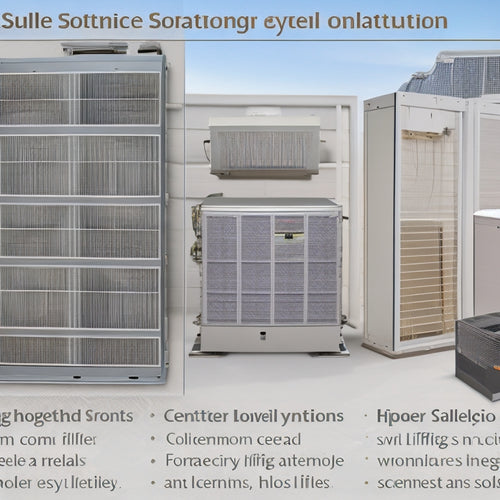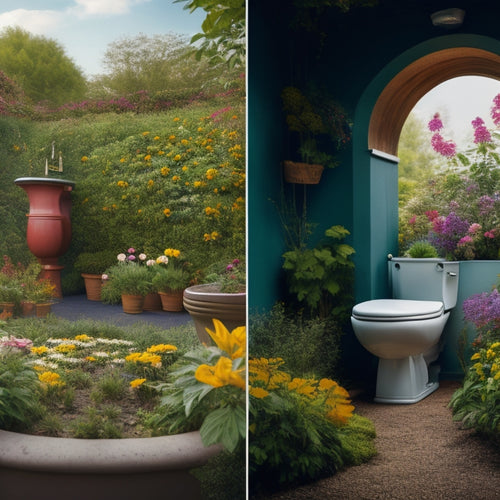
Why Choose Cool Roofs for Energy Savings?
Share
By choosing cool roofs, you can considerably reduce your energy costs and carbon footprint. Unlike traditional roofs that absorb sunlight and heat, cool roofs reflect it, leading to lower indoor temperatures and energy consumption. This results in cost savings of up to 50% in hot and dry climates, 20-30% in temperate climates, and 10-20% in cool and humid climates. Furthermore, cool roofs have environmental benefits, such as mitigating the urban heat island effect and reducing greenhouse gas emissions. As you investigate the benefits of cool roofs, you'll uncover how they can also increase your property value and provide a range of aesthetic and maintenance advantages.
Key Takeaways
- Cool roofs reduce energy consumption by reflecting sunlight and heat, leading to lower energy bills and a more comfortable indoor environment.
- Installation of cool roofs can save up to 50% on energy costs, depending on the climate zone and local temperatures.
- Cool roofs have higher thermal resistance, reducing heat transfer and contributing to lower cooling costs and extended HVAC system lifespan.
- By reducing the urban heat island effect, cool roofs also mitigate the impact of heatwaves on urban environments and local ecosystems.
- Long-term energy savings and reduced maintenance costs can offset the higher upfront installation costs of cool roofs, providing a quick return on investment.
Cool Roofs Vs Traditional Roofs
Your building's roof is more than just a protective barrier from the elements; it's also a key player in your energy consumption. Traditional roofs absorb sunlight, heating up your building and increasing your energy bills.
In contrast, cool roofs are designed to reflect sunlight and heat, reducing your energy consumption and urban heat island effect. By utilizing renewable energy sources, such as solar power renewable energy sources, for EV charging stations, we can further reduce our reliance on fossil fuels and promote sustainability.
By installing a cool roof, you can lower your energy costs and enjoy a cooler, more comfortable space. Additionally, cool roofs can extend the lifespan of your roofing materials, reducing maintenance costs and waste.
Roofing Material Thermal Performance
When selecting a roofing material for energy efficiency, you'll want to take into account its heat absorption rates and thermal insulation properties.
These factors directly impact how well the roof can reflect solar radiation and reduce heat gain in your building.
In addition, integrating solar-powered systems, such as solar-powered charging solutions, can further reduce energy consumption and enhance overall energy efficiency.
Heat Absorption Rates
One key factor in determining a roof's energy efficiency is its heat absorption rate, which depends on the thermal performance of the roofing material.
You want a roof that absorbs less heat to reduce the energy needed to cool your building. Renewable energy sources, such as solar panels, can also play an essential role in reducing carbon footprint and energy costs.
In addition, integrating green roofs with solar panels can further enhance energy efficiency.
-
Dark-colored roofs: Absorb up to 90% of solar radiation, contributing to the urban heat island effect and increasing energy costs.
-
Conventional roofs: Absorb around 70% of solar radiation, still contributing to urban heat islands and driving up cooling costs.
-
Cool roofs: Absorb as little as 20% of solar radiation, reducing the urban heat island effect and slashing energy costs for urban cooling.
Thermal Insulation Properties
Thermal insulation properties, a critical aspect of roofing material thermal performance, play an essential role in regulating heat transfer between the building and the atmosphere.
You want a roof that can effectively resist heat flow, reducing the amount of heat that enters your building. This is where thermal resistance comes in – it's a measure of a material's ability to resist heat flow. A higher thermal resistance means better insulation and, consequently, improved energy efficiency.
Moreover, implementing sustainable fuel options can also contribute to reducing greenhouse gas emissions and operating costs. Additionally, optimizing route planning and logistics can also minimize congestion and reduce emissions.
When choosing a cool roof, look for materials with high thermal resistance values. This will help you minimize heat gain during summer and heat loss during winter, resulting in significant energy savings and a more comfortable indoor environment.
Energy Savings by Climate Zone
Across various climate zones, you'll find that cool roofs offer differing levels of energy savings, depending on factors such as local temperatures, humidity, and sunlight exposure.
This variability is essential to understand, as it directly impacts your energy efficiency and overall climate adaptation strategy. By investing in EV infrastructure with solar charging stations, businesses can enhance their brand reputation and offset initial investment costs with renewable energy incentives.
Furthermore, switching to green electricity reduces carbon footprint and operating costs for commercial fleets.
-
Hot and dry climates: Cool roofs can save up to 50% on energy costs by reducing cooling loads and minimizing heat gain.
-
Temperate climates: You can expect energy savings of around 20-30% by reducing both cooling and heating loads.
-
Cool and humid climates: Cool roofs can still provide around 10-20% energy savings, primarily by reducing cooling loads during warmer months.
Cool Roof Coatings and Colors
You'll find that the reflectance of a cool roof coating plays a significant role in its energy-saving capabilities, as it determines how much solar radiation is reflected back into the atmosphere.
The color of the coating also has a direct impact on the roof's surface temperature, with lighter colors typically resulting in lower temperatures.
Roof Reflectance Matters
Most commercial roofs absorb a significant amount of solar radiation, which can lead to increased energy consumption and higher cooling costs.
You can break this cycle by choosing a cool roof with high reflectance. This means the roof reflects a significant portion of the sun's radiation, reducing the amount of heat that's absorbed.
Here are three key benefits of high roof reflectance:
-
Reduced urban heat: By reflecting solar radiation, you reduce the urban heat island effect, making your surroundings cooler and more comfortable.
-
Easier roof maintenance: A cooler roof surface means less thermal stress, reducing the likelihood of cracks and damage.
-
Lower energy bills: With a cool roof, you'll consume less energy for cooling, leading to significant cost savings over time.
Color Impacts Temperature
Choosing the appropriate cool roof coating color is essential, as it greatly affects the roof's temperature and subsequent energy savings.
You may think a dark-colored roof looks sleek, but it's a heat magnet. Dark colors absorb sunlight, leading to increased heat retention and higher temperatures.
On the other hand, lighter colors reflect sunlight, reducing heat retention and keeping your roof cooler.
When selecting a color, consider the roof's purpose and surroundings. If you're in a hot climate, a lighter color is a no-brainer. In cooler climates, a darker color might be suitable.
Environmental Impact of Roofing
As the building envelope's outermost layer, roofing plays a significant role in the environmental impact of a structure, and its effects echo throughout the ecosystem.
You're likely aware that traditional roofing materials can contribute to urban heat, which has severe consequences on local ecosystems and human health. By choosing cool roofs, you can mitigate these effects and enjoy sustainability benefits.
Here are three ways cool roofs reduce environmental impact:
-
Reduced urban heat island effect: Cool roofs reflect solar radiation, reducing the temperature in urban areas and minimizing the strain on local ecosystems.
-
Lower energy consumption: By reducing the need for air conditioning, cool roofs decrease energy consumption, which in turn reduces greenhouse gas emissions.
-
Increased roof lifespan: Cool roofs last longer than traditional roofs, reducing waste and the environmental impact of frequent replacements.
Cost-Benefit Analysis of Cool Roofs
Your decision to install a cool roof is likely influenced by its potential to reduce energy consumption and mitigate the urban heat island effect. As you weigh the pros and cons, consider the following cost-benefit analysis:
| Factors | Cool Roofs |
|---|---|
| Installation Costs | Higher upfront costs compared to traditional roofs |
| Long-term Savings | Reduced energy consumption leads to lower energy bills |
| Maintenance Considerations | Less frequent replacement and repair needs |
| Aesthetic Benefits | Enhanced visual appeal and improved property value |
While cool roofs may require higher installation costs, they offer significant long-term savings through reduced energy consumption. Additionally, they require less maintenance and can enhance your property's aesthetic appeal. By considering these factors, you can make an informed decision about whether a cool roof is right for you.
Frequently Asked Questions
Can Cool Roofs Be Used on Existing Buildings or Only New Ones?
You can retrofit existing buildings with cool roof materials to reap energy efficiency benefits; it's not limited to new constructions, and with the right installation, you'll start saving energy and reducing your carbon footprint in no time.
Are Cool Roofs Suitable for All Types of Buildings, Including Homes?
You'll be interested to know that 75% of California's commercial buildings can benefit from cool roofs. When it comes to homes, you'll find that cool roofs are suitable for most, offering energy efficiency through various material types, such as coatings, membranes, and shingles.
Do Cool Roofs Require Special Maintenance or Upkeep?
You'll find that cool roof materials, designed for energy efficiency, require minimal upkeep; occasional debris removal and inspections guarantee peak performance, allowing you to enjoy the benefits of reduced energy consumption without added maintenance burdens.
Can Cool Roofs Be Installed by Non-Professionals or Diyers?
You can attempt a DIY installation, but it's essential to follow precise guidelines when working with cool roof materials, as improper application can lead to reduced performance and compromised energy efficiency.
Are There Any Local Building Codes or Regulations for Cool Roofs?
You'll need to research local building codes and regulations for cool roofs, as they vary by region, and some areas offer local incentives for environmentally friendly installations that reduce environmental impact and promote sustainable development.
Related Posts
-

Why Solar HVAC Filters Revolutionize Home Energy Efficiency
By adopting solar HVAC filters, you're shifting your home's energy reliance from fossil fuels to clean, renewable sou...
-

Why Transform Human Waste Into Garden Gold?
By changing human waste into garden gold, you'll reduce waste management costs, support sustainable agriculture, and ...
-

5 Ways Geothermal Power Boosts Electric Vehicle Efficiency
You're likely unaware that geothermal power can greatly enhance your electric vehicle's (EV's) performance, range, an...


